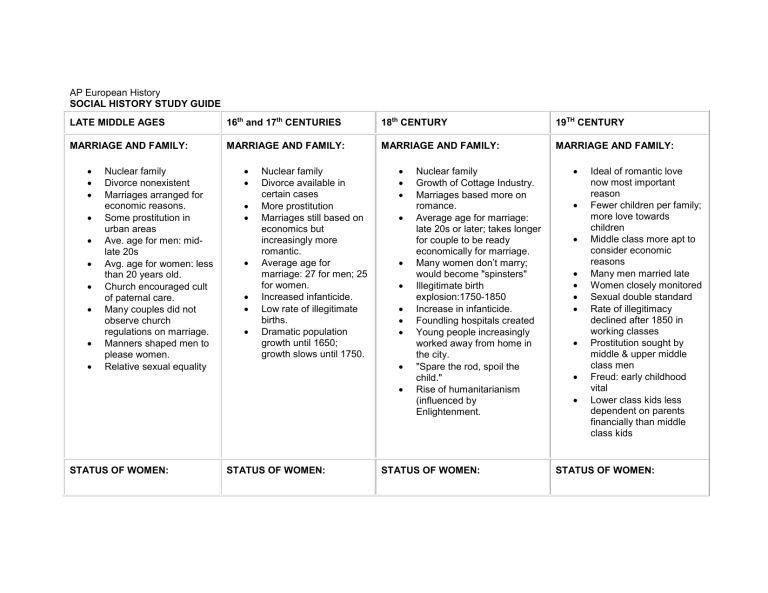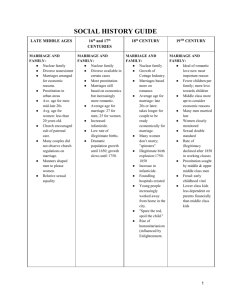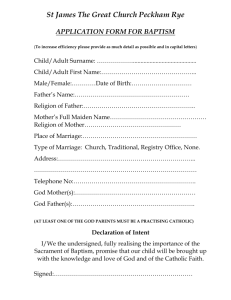
AP European History SOCIAL HISTORY STUDY GUIDE LATE MIDDLE AGES 16th and 17th CENTURIES 18th CENTURY 19TH CENTURY MARRIAGE AND FAMILY: MARRIAGE AND FAMILY: MARRIAGE AND FAMILY: MARRIAGE AND FAMILY: Nuclear family Divorce nonexistent Marriages arranged for economic reasons. Some prostitution in urban areas Ave. age for men: midlate 20s Avg. age for women: less than 20 years old. Church encouraged cult of paternal care. Many couples did not observe church regulations on marriage. Manners shaped men to please women. Relative sexual equality Nuclear family Divorce available in certain cases More prostitution Marriages still based on economics but increasingly more romantic. Average age for marriage: 27 for men; 25 for women. Increased infanticide. Low rate of illegitimate births. Dramatic population growth until 1650; growth slows until 1750. STATUS OF WOMEN: STATUS OF WOMEN: Nuclear family Growth of Cottage Industry. Marriages based more on romance. Average age for marriage: late 20s or later; takes longer for couple to be ready economically for marriage. Many women don’t marry; would become "spinsters" Illegitimate birth explosion:1750-1850 Increase in infanticide. Foundling hospitals created Young people increasingly worked away from home in the city. "Spare the rod, spoil the child." Rise of humanitarianism (influenced by Enlightenment. STATUS OF WOMEN: Ideal of romantic love now most important reason Fewer children per family; more love towards children Middle class more apt to consider economic reasons Many men married late Women closely monitored Sexual double standard Rate of illegitimacy declined after 1850 in working classes Prostitution sought by middle & upper middle class men Freud: early childhood vital Lower class kids less dependent on parents financially than middle class kids STATUS OF WOMEN: Status of upper-class women better than in next two centuries. EDUCATION: Status of upper-class women declines in Renaissance. Most women not affected by Renaissance. Educated women allowed involvement but subservient to men. Sexual double standard Woman was to make herself pleasing to the man (Castaglione) Rape not considered serious crime. Protestant Reformation: women’s occupation is in the home. Catholic orders for women grew. EDUCATION: Mostly for upper-classes Protestant women still expected to manage the home. Upper-class Catholic women had self-development options in religious orders. EDUCATION: Protestantism spurred increased education for boys and girls. Humanitarianism of Enlightenment led to improved education After 1850, increasingly separate spheres: men worked in factories; women stayed at home. By late-19th century, women worked outside the home only in poor families Middle class women began working to organize and expand their rights EDUCATION: Increase among middle class RELIGION: Dominated by Catholic Church Reform movements: Wyclif and Hus. Some persecution of witches RELIGION: NUTRITION AND HEALTH Poor harvests created malnutrition. Black Plague resulted in loss of 1/3 of population. NUTRITION and HEALTH: SOCIAL STRUCTURE: Feudalism dominated Protestant Reformation Catholic Counter Reformation Religious wars "New Monarchs" and Absolute Monarchs take control of national churches. Major persecution of alleged witches. Poor life expectancy (about 25 years) Price Revolution = less food consumption due to higher prices (until about 1650). Bread is staple food for poor classes. Upper-classes eat large quantities of meat. Smallpox and famines still ravaged parts of Europe. SOCIAL STRUCTURE: Population growth began RELIGION: Protestant "Pietism" in Germany. Rise of Methodism Catholic piety remains. Decrease in witch hunts RELIGION: NUTRITION and HEALTH Improved diet: more vegetables (esp. potato). Increased life expectancy from 25 years to 35 years. Major advances in control of plague and disease (esp. Small Pox—Edward Jenner) William Harvey: Circulation of Blood Development of public health Hospital reform Reform for mental health institutions SOCIAL STRUCTURE: Cottage Industry in rural Rerum Novarum Syllabus of Errors Kulturkampf Increased emphasis on morality among middle class Decline among urban working classes. NUTRITION and HEALTH Public Health Movement: Bentham & Chadwick Bacterial Revolution: Pasteur-"germ theory" Antiseptic (Lister) Increased life expetancy Significant decline in infant mortality after 1890 Poor living conditions in cities SOCIAL STRUCTURE: Increased standard of most of Europe. in 16th century until about 1650. Cities grew faster than rural areas. Two major hierarchies existed: Countryside: landlords, peasants, landless laborers Urban: merchants, artisans, laborers Clergy, lawyers, teachers, & civil servants fit awkwardly in both hierarchies. Advancement up the hierarchy possible through education. Enclosure movement Cottage Industry / Putting-out system Serfdom in eastern Europe areas. Growth of cities. Serfdom in eastern Europe. living for average person; higher wages Society more diverse and less unified Middle Class Upper Middle Class: Banking; industry; largescale commerce Diversified middle class groups: Moderately successful industrialists, merchants, professionals (doctors, lawyers) Lower Middle Class: Shopkeepers, small traders Lower Class: (80% of pop.) Highly skilled: Foremen; highly skilled handicraft trades Semi skilled: Craftspeople Low skilled: day laborers; domestic servants




